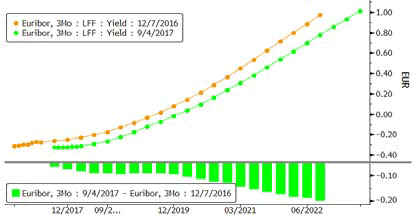- ECB ready to extend APP and reduce monthly amount of purchases
- Strong growth, but tame inflation warrants such scenario
- Curve steepening; Draghi able to prevent more unwarranted euro strength?
ECB President Draghi informed markets at the July press conference that the central bank would have significant discussions on its policy stance in autumn. He refused to clarify whether this timeframe referred to the September or October (26) policy meeting. So, markets are unsure as to whether this week’s ECB press conference will produce any significant news in terms of the ECB policy outlook.
The most likely market moving development would probably be in relation to the ECB’s Asset Purchase Programme. The current forward guidance reads that "net asset purchases, at the current monthly pace of €60 billion, are intended to run until the end of December 2017, or beyond, if necessary, and in any case until the Governing Council sees a sustained adjustment in the path of inflation consistent with its inflation aim.". Markets will be keen to see whether and to what extent this guidance might be altered on Thursday.
APP: Extend and recalibrate?
As we approach the current specified target date of end December, we expect the ECB to adapt its guidance to clear uncertainty in markets and avoid unwarranted speculation/nervousness in the months running up to the year-end. Draghi and Co could use the playbook they’ve put together in December 2016. Nine months ago, the central bank was in a more or less similar situation as the APP guidance noted that purchases were intended to run until the end of March 2017, or beyond, if necessary. The ECB then decided to lengthen asset purchases, but also to "recalibrate" the monthly amount (from €80bn/month to €60bn/month) in order to adapt to the changing/improving economic reality. A similar approach could well be followed tomorrow or at the latest on the October meeting.
Expectations for some modification of the current pace of asset purchases increased immediately after a speech by ECB President Draghi in Sintra (June 27) in which he noted that "As the economy continues to recover, a constant policy stance will become more accommodative, and the central bank can accompany the recovery by adjusting the parameters of its policy instruments – not in order to tighten the policy stance, but to keep it broadly unchanged". However, Mr Draghi also referred to financial conditions in that speech, suggesting the alternative view that he could use the argument of a stronger euro as making policy less accommodative.
Whether Mr Draghi is forthcoming tomorrow or not, we expect the ECB to extend purchases until the end of June 2018 or beyond if necessary with a reduction of asset purchases from €60bn/month to €30bn/month taking effect from the start of 2018. Regardless of the preferred monetary stance, lowering the monthly amount of bond purchases is also becoming necessary for technical reasons as the ECB is in danger of running into issue(r) limits for several EMU countries.
This phased process of policy normalization can then be stepped up next year with the ECB signaling at the end of Q1 2018 that APP won’t be extended beyond June 2018 and preparing markets for a first rate hike in Q4 2018.
Strong growth, but tame inflation
The mix of strong EMU growth momentum and tame inflation readings both warrants and allows the ECB room for manoeuvre to implement a gradual and well signalled path for ending APP, but not suddenly hitting the brakes. EMU Q2 GDP growth remained above trend (0.6% Q/Q) while the EMU composite PMI now records 55+ readings for seven months running. New GDP forecasts from the ECB should reflect those developments, especially in 2017/2018. Strong activity data are accompanied by an improving labour market, even if some slack remains.
There’s less optimism from the inflation front. Headline CPI rose to 1.5% Y/Y in August, and although it has trended higher over the past year core inflation remains lacklustre at 1.2% Y/Y. The euro’s appreciation since the ECB’s June projections (+/- 4% on a trade-weighted basis) suggests that next year’s inflation forecast could be cut further, despite the positive effect from stronger GDP expectations. ECB President Draghi will therefore reiterate that "a very substantial degree of monetary accommodation is still needed for underlying inflation pressures to gradually build up and support headline inflation developments in the medium term."
Curve steepening and correction euro?
We return to the December 2016 policy meeting in order to assess the potential market impact from the scenario outlined above. The market reaction was dovish: the German yield curve steepened (lower ST yields, higher LT yields), the euro lost ground and equities profited after Draghi explained the future of APP.
A new steepening of the German yield curve is likely, but this may be a little less than was the case in December. First of all, because the ECB in December changed some technical parameters of APP. One of them was the inclusion of bonds with a 1-2 yr maturity. Second, (rate) markets are now positioned more dovishly than they were on the eve of the December 2016 policy meeting. The Euribor 3m strip curve trades 10 to 20 bps lower on tenors between 2018 and 2022. Both factors suggest that the downward potential of short term German yields is much lower than the 6 bps drop we witnessed in December last.
That said, in order to cause German short term yields to significantly increase, the ECB would probably have to change its forward guidance ("we expect rates to remain at their present levels for an extended period of time, and well past the horizon of our net asset purchases") which we only expect to happen in Q1 2018.

Euriobor 3m strip curve: Markets more dovish positioned than ahead of December 2016 ECB meeting
The German 10-yr yield currently trades around similar levels to 9 months ago. A further reduction in bond purchases could push longer term yields again higher, especially against the background of strengthening growth.
The December 2016 meeting started the euro’s dive to the current cycle low (EUR/USD 1.0350 area) around the turn of the year. The recent nature of the climb to current levels (EUR/USD 1.19) suggests that euro bulls could take some chips off the table in the outlined scenario, resulting in a more neutral FX market positioning and consolidation. The downside of EUR/USD seems nevertheless limited given already relatively dovish rate expectations. Dollar positive news is necessary to trigger a more sustained correction lower.
Extending the APP-programme would also fit in the central bank’s recent warnings/concerns on euro strength. ECB July Minutes remarked that "concerns were expressed about the risk of the exchange rate overshooting in the future". Draghi will probably again put the onus on the single currency’s strength to avoid an unwarranted rise. However, he will also need to be careful not to give the impression that the ECB wants to manage the exchange rate.














